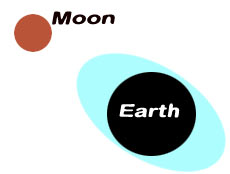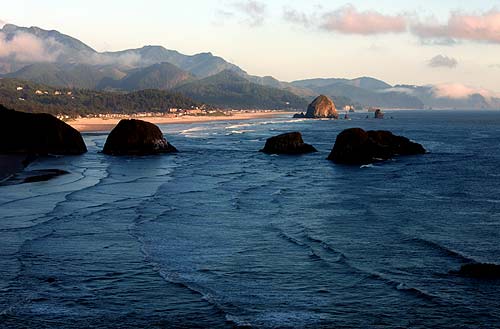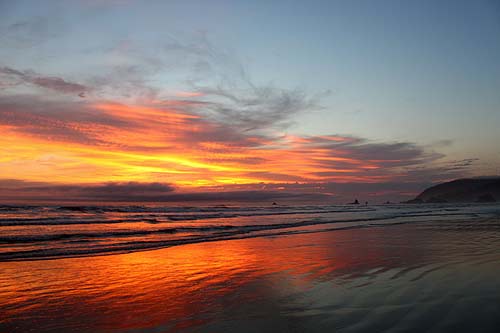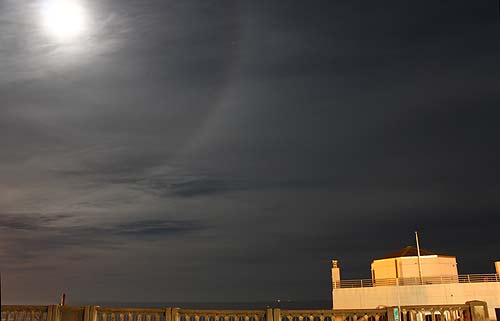Oregon Coast Science: How Tides Work, How They Push Moon Away
Published 07/05/2015 at 8:04 PM PDT
By Oregon Coast Beach Connection staff

(Oregon Coast) – How do tides work on the Oregon coast? What makes them come in for a few hours? Then makes them go back out?
The answer goes deeper than you'd imagine and farther out into space, too. Then there the stunning side effects of tidal forces on the Earth and the oceans that involve the moving getting pushed away and the days getting longer over the centuries.
 |
| Gravity from the moon creates a bulge (in light green) in the oceans on both sides of the Earth |
First, a little more down to Earth, on the Oregon coast:
Dr. Bill Hanshumaker, public information officer with the Hatfield Marine Science Center in Newport, said tidal changes on the Earth and the Oregon coast happen because the moon is tugging at the oceans. Gravity makes a bulge in the bodies of water, which creates the high tide. On the opposite side of the Earth there is another high tide, because of the inertia of the ocean water, and because the Earth is being pulled towards the moon but the ocean water lags behind. This creates another “bulge” on the other side.
Consequently, these bulges on both sides of the Earth create low spots at the points in between the bulges. These are the minus tides.
“It has to do with the tilt of the Earth and the bulge of gravity on the water from the sun and the moon,” Hanshumaker said. “It depends on the geography of the place as well. It depends on where you are, and if that place is closest to the moon because of the tilt.”
Hanshumaker said the Oregon coast is in and around the 45th parallel, which is halfway between the pole and the equator. That can make a difference in low tides and high tides as well.
There are also other seasonal forces at work on these kinds of tides. Weather conditions, of course, play another part, especially with high tides.
“There are some sideways forces that affect the tides too,” Hanshumaker said. “Currents can affect the tides as well. These move in directions that increase or decrease a tide.”
Hanshumaker pointed to the Bay of Fundy in Nova Scotia as a particularly wild example of topography affecting the tides. That spot has the widest tidal range in the world, swinging back and forth as much as 50 feet.
Geographic location can play a major role in the times and depth of tides between the north and central Oregon coast as well. Tidal events, such as low or high tides, can differ by hours between Newport and Seaside, which are about 140 miles from each other. The height or depth of these can be quite different as well.
Seaside Aquarium's Tiffany Boothe asked NOAA about this difference a few years back.
“They told me it has to do with where you’re taking the measurements, as well as topography of the area, and other aspects,” Boothe said. “So we not only have different high and low tide numbers, but they can happen at slightly different times – even only a little over one hundred miles away.”
Then again, as scientists are quick to point out, tide tables are not written in stone. They are just predictions. Wind, rain, freshwater water run-offs and other geographic factors can influence the tides on top of everything else.
Another topgraphy example: the area around southern Seaside is particularly prone to winter flooding when the right combo of high tides and high seas driven by wind mix with heavy rains that raise the creek levels. Until recent years, this caused a chunk of Highway 101 in that area to become inaccessible at times. ODOT fixed that road issue recently.
Weirder still, tidal forces between the oceans, the Earth's crust and the Moon are actually slowly – very slowly – making the days longer. It's even sending the Moon away from us.
According to astronomy icon Neil DeGrasse Tyson, the Earth's rotation is slowing by about 1/500 of a second every century. This means every 100 years, a day is 1/500 of a second longer. Tyson said in a 1995 article that a day will last some 1,000 hours in about one trillion years.
These tidal forces are also pushing the Moon away by two inches each year. Scientists know this because Apollo astronauts set out highly reflective objects, which obervatories shine lasers on to get exact measurements.
All this has to do with tidal forces yanking on the Earth's crust, almost as much as the bulges this causes in the oceans. Those two forces are working against each other, which slows down the Earth's rotation and nudges the Moon away.
More about Oregon Coast Science.





More About Oregon Coast hotels, lodging.....
More About Oregon Coast Restaurants, Dining.....
LATEST Related Oregon Coast Articles
Likely just before dawn best hour but peak happens during daylight. Weather
Dark Sky Week is Prime Along Oregon Coast: Where and Where Not to Go
General guide to dark sky viewing from south to north coast. Astronomy
Sizable Price Drop, Deals in Lincoln City During Quiet of April on Central Or...
20 perc off at A1 Vacation Rentals across its roster, including Gleneden Beach. Lincoln City specials
Upcoming S. Oregon Coast Events Include Gem Show, History: Coos Bay, Bandon
May 6 talk at Coos History Museum, Mayfly Fest May 17, Bandon Rock / Gem Show June 7,8
Washington Coast Cleanup on April 19 - Coinciding with Oregon Coast's SOLVE E...
From the Puget Sound to Long Beach, alongside Oregon's cleanup. Washington coast events, Seaside events
Astoria's Riverwalk Gets New Lighting, More N. Oregon Coast Roadwork
Delays coming this summer, but the riverwalk has a new look. Seaside, Cannn Beach
April Gets Even Cheaper Midweek at Depoe Bay, Lincoln City: Oregon Coast Deals
Off-season rates plus more at Keystone Vacation Rentals. Depoe Bay lodging specials, Lincoln City hotel reviews, Newport hotel reviews
Washington Coast Begins Week of Clam Digs, April 12 Through 18
Long Beach, Twin Harbors, Mocrocks and Copalis at different times. Washington coast events
Back to Oregon Coast
Contact Advertise on BeachConnection.net
All Content, unless otherwise attributed, copyright BeachConnection.net Unauthorized use or publication is not permitted












































